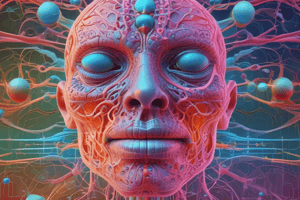Podcast
Questions and Answers
What role do efferent pathways play in homeostatic systems?
What role do efferent pathways play in homeostatic systems?
- They carry signals from muscles to the brain.
- They send signals from the body to the brain.
- They carry signals from the brain to muscles or glands. (correct)
- They act as effectors in the body.
Which anatomical term describes a structure closer to the body's midline?
Which anatomical term describes a structure closer to the body's midline?
- Proximal
- Lateral
- Medial (correct)
- Distal
What is the correct order of the levels of organization in biological systems?
What is the correct order of the levels of organization in biological systems?
- Chemical → Cellular → Tissue → Organ System → Organ → Organism
- Chemical → Cellular → Tissue → Organ → Organ System → Organism (correct)
- Organ → Organ System → Tissue → Cellular → Chemical → Organism
- Cellular → Tissue → Organ → Organ System → Chemical → Organism
Which body cavity contains both the pleural and pericardial cavities?
Which body cavity contains both the pleural and pericardial cavities?
Which type of biological macromolecule primarily serves as enzymes?
Which type of biological macromolecule primarily serves as enzymes?
What type of molecule does not mix with water?
What type of molecule does not mix with water?
What effect do enzymes have on chemical reactions?
What effect do enzymes have on chemical reactions?
What term describes a protein structure that loses its shape and function?
What term describes a protein structure that loses its shape and function?
What process involves the formation of bone from cartilage?
What process involves the formation of bone from cartilage?
Which cells are primarily responsible for breaking down bone?
Which cells are primarily responsible for breaking down bone?
Which type of joint allows for the widest range of movement?
Which type of joint allows for the widest range of movement?
What does red bone marrow primarily produce?
What does red bone marrow primarily produce?
Which hormone increases calcium levels by stimulating osteoclasts?
Which hormone increases calcium levels by stimulating osteoclasts?
What is the first step in the bone repair process after an injury?
What is the first step in the bone repair process after an injury?
What primarily contributes to the thickening of bone tissues?
What primarily contributes to the thickening of bone tissues?
Which type of bond involves the sharing of electrons?
Which type of bond involves the sharing of electrons?
Flashcards are hidden until you start studying
Study Notes
Homeostatic Systems
- Efferent pathway transmits signals from the brain to muscles or glands.
- Afferent pathway conveys signals from the body to the brain.
- Effectors are muscles or glands that act in response to signals.
- Negative feedback mechanisms reduce the impact of changes, such as regulating body temperature.
- Positive feedback mechanisms enhance responses, such as during childbirth.
Anatomical Terms
- Proximal refers to a position closer to the body's trunk.
- Deep indicates a location farther from the body surface.
- Anterior means toward the front of the body.
- Ipsilateral describes structures on the same side of the body.
- Sagittal plane divides the body into left and right halves.
- Transverse plane separates the body into upper and lower sections.
Levels of Organization of Life
- The organization progresses from chemical structures to cellular forms, followed by tissues, organs, organ systems, and ultimately the organism.
Body Cavities
- Pleural cavity encases the lungs.
- Pericardial cavity contains the heart.
- Thoracic cavity includes both pleural and pericardial cavities.
Biological Macromolecules
- Carbohydrates serve as energy sources, encompassing sugars and starches.
- Proteins function as enzymes and structural components like muscle fibers.
- Lipids provide energy storage and form cellular membranes.
- Nucleic acids, including DNA and RNA, are essential for genetic material.
Hydrophobic vs. Hydrophilic vs. Amphipathic
- Hydrophobic substances do not mix with water, exemplified by fats.
- Hydrophilic substances readily dissolve in water, such as salts.
- Amphipathic molecules possess both hydrophobic and hydrophilic properties, as seen in soaps.
Chemical Reactions and Enzymes
- Factors influencing reaction speed include temperature, concentration, and the presence of enzymes.
- Enzymes are proteins that accelerate chemical reactions by reducing required energy.
Protein Structure Levels
- Primary structure consists of a linear sequence of amino acids.
- Secondary structure involves the formation of helices or sheets.
- Tertiary structure refers to the three-dimensional folding of proteins.
- Quaternary structure forms when multiple protein chains aggregate.
- Denaturation describes the process where a protein loses its functional shape.
Atomic Terms
- Atomic number represents the quantity of protons in an atom.
- Ions are electrically charged atoms—cations carry a positive charge, while anions are negatively charged.
Laws of Thermodynamics
- The first law states that energy cannot be created or destroyed but can transform.
- The second law asserts that energy transformations create increased disorder (entropy).
- Body heat is a byproduct of metabolic processes.
Cell Components
- Nucleus houses genetic material (DNA).
- Endoplasmic reticulum synthesizes proteins and lipids.
- Plasma membrane regulates the passage of substances in and out of the cell.
Molecular Shapes
- Monosaccharides are simple sugars like glucose.
- Triglycerides are a type of fat molecule.
- Steroids are hormones characterized by their ring-like structures.
Hydrolysis vs. Dehydration
- Hydrolysis involves breaking molecules apart through the addition of water.
- Dehydration synthesis connects molecules by removing water.
Monomers and Polymers
- Proteins are polymers composed of amino acid monomers.
- Nucleic acids are formed from nucleotide monomers.
- Lipids consist of fatty acid components.
- Carbohydrates are derived from sugar monomers.
Bone Tissue Structure
- Osteons serve as functional units of bone structure.
- Osteocytes are cells that maintain bone tissue.
- Osteoblasts are responsible for bone formation.
- Osteoclasts function to break down bone tissue.
Bone Ossification
- Endochondral ossification involves the transformation of cartilage into bone.
- Intramembranous ossification creates bone directly from connective tissue.
- Bone resorption is the process by which osteoclasts degrade bone.
Bone Growth
- Lengthening of bones occurs at the growth plate known as the epiphyseal plate.
- Thickening arises through the addition of bone tissue to the outer surface.
Bone Marrow
- Red marrow is responsible for blood cell production and is located in spongy bone.
- Yellow marrow primarily serves as a fat storage site within long bones.
Osteoblasts Source
- Osteoblasts originate from stem cells found within bone tissue.
Blood Supply to Bone
- Blood enters the bone through nutrient foramina and travels via internal canals.
Skeletal System Functions
- The skeletal system provides structural support, protection for vital organs, facilitates movement, and stores calcium.
- Vitamin D is crucial for the absorption of calcium.
Bone-Regulating Hormones
- Parathyroid hormone (PTH) elevates calcium levels by promoting osteoclast activity that breaks down bone.
Knee Joint
- The knee is classified as a synovial joint, enabling smooth movement.
- Types of movement include hinge, as seen in the knee, and ball-and-socket, as in the shoulder.
Bone Injuries
- Common injuries include torn meniscus and arthritis.
- Cartilage cushions joints and is a vital component in areas like the knee.
Bone Repair Steps
- The process initiates with blood clot formation, followed by soft callus development, hard callus formation, and finally, bone remodeling.
Chemical Bonds
- Hydrogen bonds are weak interactions between molecules.
- Covalent bonds involve the sharing of electrons between atoms.
- Ionic bonds result from electron transfer, leading to ion formation.
Other Terms
- Osteoid refers to bone tissue before its mineralization and hardening.
- Stem cells possess the potential to differentiate into various cell types.
- G0 is the resting phase in the cell cycle when a cell is not actively dividing.
Bone Pathologies
- Gigantism is characterized by excessive growth resulting from hormonal imbalances.
Studying That Suits You
Use AI to generate personalized quizzes and flashcards to suit your learning preferences.




